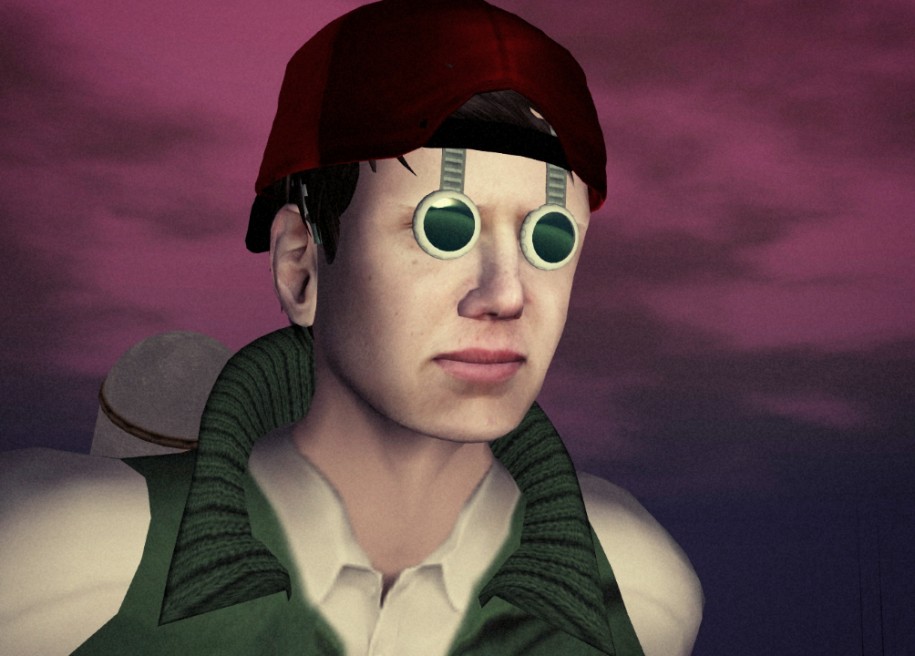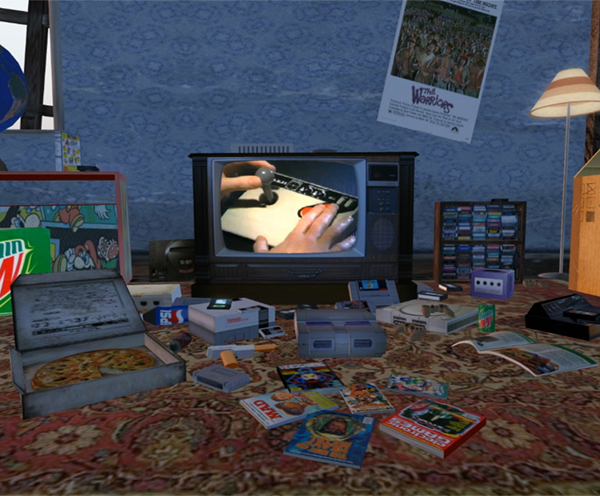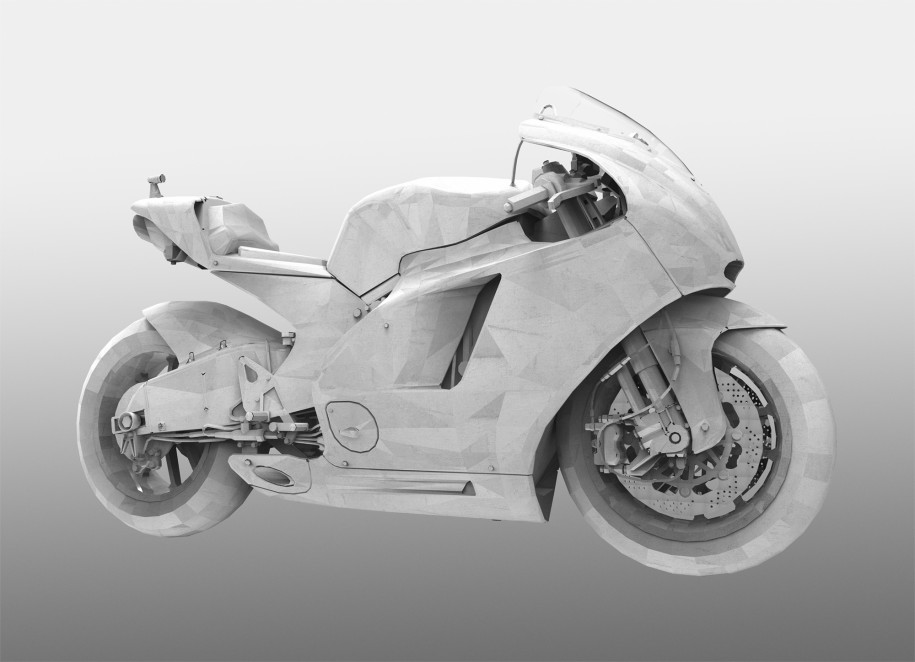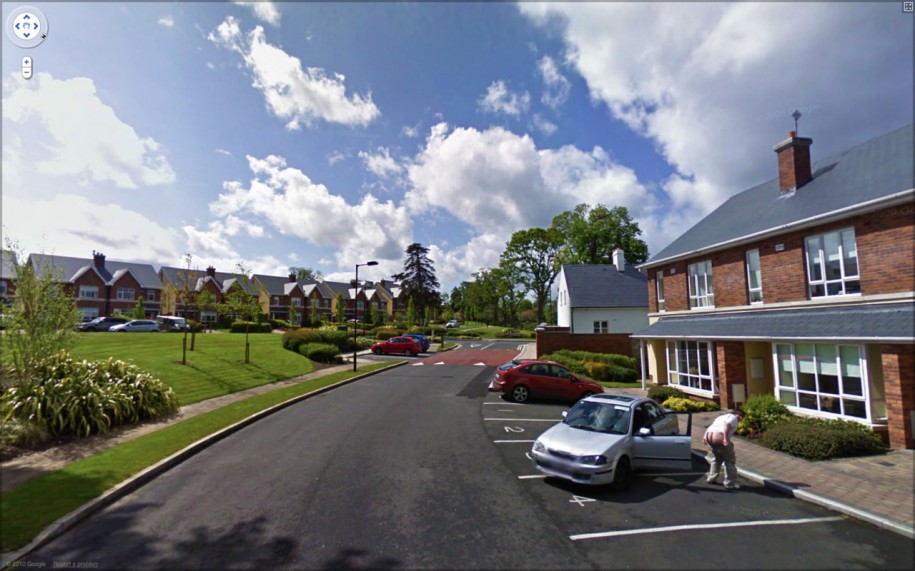WEB SPECIALS
JON RAFMAN
interview by Keller/Kosmas
(Aids-3d)

Courtesy of the artist
KELLER/KOSMAS (AIDS-3D) As an artist you’ve got a lot of different things going on. Do you think it’s important as an artist to have a seemingly cohesive body of work, or at least some kind of delineation between different sub-practices. Could you outline some structure that organizes your practice as a whole?
JON RAFMAN What ties my practice together is not so much a particular style, form, or material but an underlying perception of contemporary experience and a desire to convey this understanding. One theme that I am continually interested in is the way technology seems to bring us closer to each other while simultaneously estranging us from ourselves. Another one is the quest to marry opposites or at least have conversations between them, the past and the present, the romantic and the ironic, even though these conversations often end in total clashes. All my work tends to combines irony, humor and melancholy.
A3D What for instance connects Brand New Paint Job to say Codes of Honor?
JR We live in an age in which the new is constantly sweeping away or destabilizing history and tradition at faster and faster rate. But in the past, situating oneself within history and tradition was a classic way by which an individual redeemed himself or built a coherent self. One of the connections between Codes of Honor and BNPJ is that each one in its own way examines the implications of this loss, this changing role of history and tradition. In BNPJ there is a clash of cultural weights between the texture (2d painting) and the underlying structure (3d object). History (like a BNPJ) is ultimately wrapped around whatever we do. In Codes of Honor, the narrator is profoundly sad that the time when his life had meaning, solidarity, and achievement is now irrevocably over, but the lack of tradition and history inherent to a video game blocks his path to give life new meaning.

Courtesy of the artist
A3D How do you think an idea of territorialism fits in to your work.? I mean this in a few ways, 1st literally, in Google Street Views and Second Life tours, you’re literally exploring pubic spaces and sorta claiming them for your practice.
JR If I use a public space for a critical or creative purposes, I view it as “my territory.” Yet it is mine no more or no less than that of any other artist.
A3D But I also wonder about whether or not you believe in any idea of artistic territory, or is this an increasingly outmoded way of categorizing artistic practice? (In the sense that Seth Price owns vacuum sealed ropes or Cory Arcangel owns Nintendo hacks)
JR Personally I find it outmoded, but as an artist it is very important to be aware of what came before you, otherwise you might make references in your work without being conscious of it. I do think it is important to ‘own’ your work in that sense.
A3D Being a bit open and dilettantish is obviously easier than ever, but do you think that it is a good move for a young artist just starting a career? I wonder this myself, as we’ve jumped around a whole lot in 5 years of work, and I’ve heard many times that its hard to see a visual continuity within aids-3d.
JR I don’t quite see it that way. I see a definite continuity, both visual and conceptual, in Aids-3d. But I think we struggle with similar issues of not fitting easily into an artistic type or genre. The themes running through our work are consistent, yet we are just always looking for different modes of expressing them? I am constantly searching for an ideal, be it a girl, a mentor, the sublime, while simultaneously trying to reveal the sadness that accompanies the loss of these ideals or the failure to achieve them.

Courtesy of the artist
A3D You’ve started getting some success in the art market in the past year or so, do you think that the “market forces” will lead you towards a more crystalized and apparent Jon Rafman style, or do you think that commercial support could allow you to be even more experimental?
JR I don’t think I will ever be able to settle on any one way of making work even if I ever have huge market success. If a Jon Rafman style develops it won’t be the result of a conscious effort. Although financial success would help make it easier for me to afford to make things that I would not otherwise be able to. For example, l would love to create a real life Malevich Ducati or make a feature length film. Money would allow me to be more experimental in that way.
A3D I think that maybe the most crucial element in your work, do you have different rules when you’re exploring Second Life versus Google Street View?
JR The rules are constantly evolving and changing and I often only become aware of them in retrospect. This may not be what you have in mind, but if I were to give any rule I think the main one that guides me is the desire to find or produce something genuinely new without necessarily knowing what it is in advance. I really want to create something that can both act on the future and the past; an art that is new and yet finds continuity with art history. I think that a new art re-works and transforms, retrospectively, the history of art.
We went to see an excellent Post Modernism exhibition at the V&A in London together and I remember you reached a point when you started getting depressed because it was so clear that so much of the stuff going on right now amongst our peers was a just a repetition of what had already happened. Now I think that gloomy feeling is valid because, on one level, repetition is a form of regression, for as we move further and further away from the original source our consciousness of the historical condition lessens. But there is also an emancipatory character to repetition if the repetition is made explicit. Maybe as artists we are continually driven to re-attain lost moments in art history but in new ways.

Courtesy of the artist
A3D I can see how one might take the poignant and sometimes tragic subject matter of your Google Street Views as being a bit exploitative (clearly the people depicted have given no consent). Do you feel that you have the same responsibilities towards your subjects as a traditional street photographer might have? Does the technological mediation give you a free pass to depict whatever you find?
JR I believe I advocate the total autonomy of the artist to capture or create whatever he or she may please, even though I know that this is an aspiration rather than an achieved state. I think it is important to be conscious of the potential exploitative nature of one’s art but I also think that, if you start making decisions based on political or moral correctness, your art ceases to be autonomous. Yet, I think all artists have to take responsibility for their creation. And that it is very possible for an artist not to actually see the truth in their work, it is possible for a photographer to be blind towards what he is photographing. A classic example of this in film is in the movie Blow Up. At first, the protagonist does not see the actual murder taking place in his photo. In order to see the reality in your work, you have to be worthy of it and truly to committed to the your creations. The moral and epistemological perspectives are intertwined. For me, that means that in order to see the truth in my Street View photos, I have to be open to the inherent violence in them. I think whenever you capture something in art or writing you are doing violence to a certain extent because you are wrenching it from the constant flow of inchoate reality.

Courtesy of the artist
A3D Recently, we both attended the #OWS protest in London. Maybe we can detour and talk about that for a little bit… I’ve always been especially taken by this one Critical Art Ensemble quote from their text Electronic Civil Disobedience, “CAE has said it before, and we will say it again: as far as power is concerned, the streets are dead capital! Nothing of value to the power elite can be found on the streets, nor does this class need control of the streets to efficiently run and maintain state institutions.”
JR I think if the streets had a coherent ideology with a revolutionary consciousness that assertion would be untrue, but the truth is that a politically effective Left has been dead for a long time now. I think this supposed renaissance of the Left can easily lead to a even further disintegration or splintering of what remains of the Left. But just to back up a little bit, I think it is important to talk about the roots of the #OWS movement and recent leftist history in order to grasp it clearly. For me, the #Occupy movement shares many similarities to the anti-globalization movements of the 1990s, most clearly expressed in the anti-WTO protests in Seattle at the turn of the millennium. For instance both movements were spearheaded by anarchist groups and have been supported by the labor movement. Both movements were “leaderless” and expressed a populist discontent. A major theme of the “post-New left”, “post-ideological” 1990s-era Left was, as in the current #Occupy movements, resistance/reaction rather than pressing for concrete liberal reforms let alone real revolution.The standard narrative is that the 90s anti-globalization movement faded out after the 9/11 attacks and became focused on attacking the Bush administration and Israel during the “War on Terror” era. But the #OWS movement is not objecting to neo-conservatism and US imperialism as in the 2000s, but to neo-liberalism and capitalism in general. While I do think that the shift away from a politics based on opposing US hegemony towards one that is based on critiquing capitalism as a whole is a good one, I do not think that any form of coherent emancipatory politic is guiding the movement. Over the past half century there has been a profound banalization and degeneration of revolutionary politics. All problems cannot simply be blamed on corruption or greed. The anti-intellectual strain in anarcho politics coming out of the #OWS movement is partly a result of the desire to reject the grand-narratives of the Old Left. There is now a conflation of lifestyle choices with political action and very little attempt to form structural critiques of capitalism. Micropolitics have totally supplanted macropolitics. I understand that there is an appealing optimism to the localist impulse, but I think behind the lightness of culture jamming and everyday politics of resistance lies something darker, a profound cynicism and sense that there is nothing ‘outside’ the current social order. There is a real despair at the failure of past revolutionary struggles which has resulted in a almost inescapable skepticism of any totalizing politics. The practice of everyday resistance (buying local/organic?) seems a lot easier and safer than methodological struggle of building a sustained alternative ideological world view. But that said, there is definitely a new possibility to articulate the current situation that I don’t think was possible while the wars in Iraq and Afghanistan were raging. Yet I have seen no clear articulation of the situation by any political leaders or movements. The #OWS movement is raising some issues that have been out of the public sphere for a little while. Like what would it mean to challenge the very structure of society? It is clear that we do not live in the best of possible worlds. Yet how could a new global political movement meet these concerns in practice? At this moment in time, I cannot imagine an revolutionary ideology good enough to meet the historical possibilities of our moment. Even conceiving the possibilities for radical transformation today is truly challenging for me.

Courtesy of the artist
A3D Continuing from that, this work to me seems to be your most overtly political, if for no other reason than its engagement with the “real world.” Do you think we have any responsibility to engage with the political issues that the world is currently embroiled in?
JR Whenever I am confronted with the question of the role of the artist in their relation to social change, I am reminded of this essay by Walter Benjamin “The Author as Producer.” In it Benjamin argues that no art can be of correct “political tendency” unless it is also of good aesthetic quality. The moment an artist’s work becomes overtly political or didactic it loses its true critical potential. Aesthetic experience for me is self-justifying. I believe that aesthetic experience reveals the critical elements of subjectivity. In the aesthetic experience, the subject recognizes not the power of experiential capacities and the transformative freedom of the human faculties, but rather their constraint and un-freedom, their self-contradictory and self-undermining powers. I think the single most important demand of the artist is to reflect. Art should provoke recognition. I think art objects have the power to ‘do’ things, and to promote social change in the “real world,” but only indirectly. Art has a role of reflection, critique and investigation of social reality, but no ‘active’ role. In this way, art is a discursive space through which it is possible to read social change. I am against the reconciliation of theory and practice or art and politics. The separation of art into its own autonomous domain is a hallmark of our freedom. The separation of theory and practice that emerged in Modernity was progress. So for me this romantic desire to dissolve the distinction and critical relationship between theory and practice, art and politics, is a sign of regression. It is very important for me to maintain a separation between art, as a non-conceptual form of knowledge, and politics and critical theory, which is informed by conceptual knowledge.



